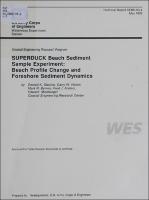Please use this identifier to cite or link to this item:
https://hdl.handle.net/11681/12624Full metadata record
| DC Field | Value | Language |
|---|---|---|
| dc.contributor.author | Stauble, Donald K. | - |
| dc.contributor.author | Holem, Garry W. | - |
| dc.contributor.author | Byrnes, Mark R. (Mark Richard) | - |
| dc.contributor.author | Anders, Fred J. | - |
| dc.contributor.author | Meisburger, Edward P. | - |
| dc.date.accessioned | 2016-07-06T14:23:59Z | - |
| dc.date.available | 2016-07-06T14:23:59Z | - |
| dc.date.issued | 1993-05 | - |
| dc.identifier.uri | http://hdl.handle.net/11681/12624 | - |
| dc.description | Technical Report | - |
| dc.description | Abstract: The purpose of the SUPERDUCK Beach Sediment Sample Experiment was to study beach response to storm waves. Data were collected during an 11-day experiment influenced by two extratropical storms. Daily beach profiles were surveyed along four lines to give a three-dimensional picture of beach response. Surface sediment samples were collected at the berm, upper swash, and lower swash to examine daily grain size distribution changes. Wave data collection from a wave gage located in 8 m of water provided changes in wave height and period during the two storms. The foreshore exhibited progressive daily erosion during the first 5 days of the experiment as the first storm event waned. The last 6 days showed a progressive accretion on the foreshore, even under the influence of the second storm. Most variability in daily sediment grain size distribution occurred in the upper swash, a zone of both uprush and backwash influence. Berm samples were finer and better sorted, deposited at the area of maximum uprush. Lower swash samples were coarser and more poorly sorted as the backwash interacted with incoming surf bores. Behavior of the foreshore was partially independent of waves as nearshore bathymetry appeared to play a dominant role in the erosion and accretion pattern. | - |
| dc.publisher | Coastal Engineering Research Center (U.S.) | - |
| dc.publisher | Engineer Research and Development Center (U.S.) | - |
| dc.relation | http://acwc.sdp.sirsi.net/client/en_US/search/asset/1032381 | - |
| dc.relation.ispartofseries | Technical report (U.S. Army Engineer Waterways Experiment Station) ; CERC-93-4. | - |
| dc.rights | Approved for public release; distribution is unlimited. | - |
| dc.source | This Digital Resource was created from scans of the Print Resource | - |
| dc.subject | Beach profiles | - |
| dc.subject | Beach morphology | - |
| dc.subject | Beach sedimentation | - |
| dc.subject | Extratropical storms | - |
| dc.subject | Foreshore | - |
| dc.subject | Grain size distribution | - |
| dc.subject | Profile sediment interaction | - |
| dc.subject | SUPERDUCK | - |
| dc.subject | Deposition | - |
| dc.subject | Coastal changes | - |
| dc.subject | Beach erosion | - |
| dc.subject | Storm surges | - |
| dc.subject | Atlantic Coast | - |
| dc.subject | Coastal sediments | - |
| dc.subject | Marine sediments | - |
| dc.title | SUPERDUCK beach sediment sampling experiment : beach profile change and foreshore sediment dynamics | - |
| dc.type | Report | en_US |
| Appears in Collections: | Technical Report | |
Files in This Item:
| File | Description | Size | Format | |
|---|---|---|---|---|
| TR-CERC-93-4.pdf | 8.87 MB | Adobe PDF |  View/Open |